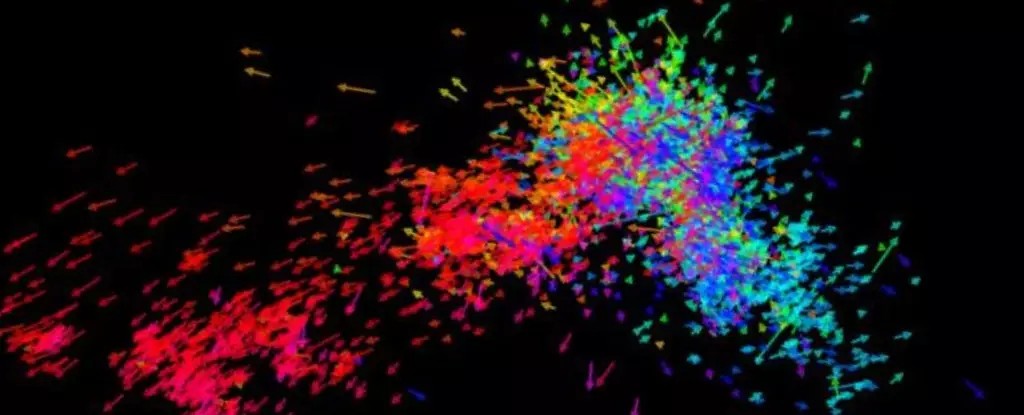In a groundbreaking study led by researchers at Nagoya University, the intricacies of the Small Magellanic Cloud (SMC) have become a focal point for understanding the dynamics of galaxies. This team, headed by Satoya Nakano and Kengo Tachihara, has unveiled data suggesting that this dwarfed galaxy is not merely an idle companion to its larger counterpart, the Large Magellanic Cloud (LMC), but rather a celestial entity grappling with the relentless forces of gravity. The findings not only challenge our perceptions of galactic stability but also raise profound questions about the evolution of galaxies in the vast cosmic arena.
The Magellanic Clouds, named after the great explorer Ferdinand Magellan, have intrigued astronomers for centuries. They radiate beauty and complexity, serving as picturesque reminders of our place in the universe as they parade across the Southern Hemisphere’s night sky. But beneath their stellar splendor lies a tale of turbulence. Approximately 160,000 and 200,000 light-years away, the SMC and LMC are engaged in a slow dance marred by chaotic gravitational interactions. It’s this very struggle that researchers aim to understand through their exploration of the SMC’s massive stars.
Unexpected Stellar Dynamics: A Revealing Discovery
The research team’s meticulous observation of 7,000 massive stars within the SMC has provided alarming insights into the galaxy’s behavior. Each of these primordial stars, boasting masses over eight times that of our Sun, acts as a beacon illuminating the turbulent nature of their surroundings. The key finding shows these stars are in motion, but not in the typical harmony expected in a galactic system. Some stars are drawn towards the LMC, while others appear to be flung out into the cosmic void, revealing the distress signals of a galaxy under siege.
This unsettling phenomenon suggests the SMC is subjected to severe tidal forces, destabilizing its stellar configuration and perhaps heralding its eventual demise. The researchers’ observations present a compelling narrative: the SMC is slowly being dismantled by gravitational interaction, creating what is now understood as the Magellanic Stream—a trailing band of gas that stretches across the southern sky as testament to the turmoil in this dynamic system.
Challenging Long-Held Beliefs
Perhaps even more astonishing is the team’s discovery concerning the rotational dynamics of the SMC’s massive stars. In stark contrast to galaxies like our Milky Way, where stars and surrounding gas typically rotate as a cohesive unit, the SMC’s stars exhibit a disjointed, chaotic motion. This suggests that the gas—generally believed to serve as the cradle for star formation—may itself lack any organized rotation. Such a revelation demands a reevaluation of the mass calculations of the SMC and its interactions within the larger gravitational triad involving the Milky Way and the LMC.
These unexpected results necessitate a fresh perspective on how we understand these cosmic entities. Traditionally, young massive stars are thought to form and move in sync with their gaseous birthplaces. The SMC’s chaotic stellar movement poses intriguing questions about the birth and development of galaxies in the universe, particularly those resembling early celestial bodies.
The Broader Implications for Cosmology
The implications of this research extend beyond the SMC itself and make significant contributions to astrophysical theories regarding galaxy formation. By acting as a living laboratory for primordial galaxies, the SMC can provide clues that illuminate the pathways and processes that lead to galactic evolution. As researchers observe this cosmic drama unfold, they stand on the precipice of redefining our understanding of galactic interactions and formations.
The SMC’s fate is a vivid reminder of the impermanence that governs the cosmos. Such violent interactions may well be the norm for younger galaxies, offering a perspective that contrasts sharply with more stable systems like the Milky Way. As we delve deeper into this field, we must be willing to discard preconceived notions and embrace the complexity that encapsulates the universe—a tapestry of stars, gravity, and lifecycles that are far more intricate than we previously imagined. The SMC’s struggle is a cosmic narrative echoing the broader story of survival and transformation, offering insights not only into the fate of a single galaxy but into the universal principles that bind us all.


Leave a Reply